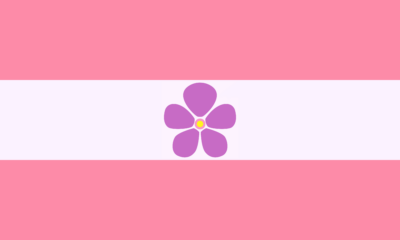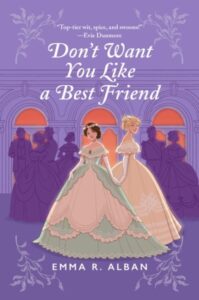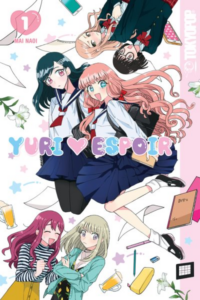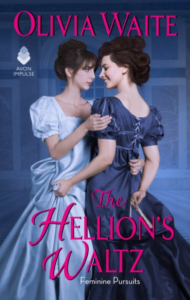The Language of Flowers
For Pride Month last year, I discussed the Yuri genre and its cultural context. In short, sapphic romance stories coming from Japan are commonly referred to as “yuri,” the Japanese word for “lily.” Yuri is a distinct subgenre of sapphic romance, containing its own tropes and genre conventions informed by Japanese culture.
While the lily has become a modern symbol of Sapphic love thanks to anime’s ubiquity across the globe, it has a predecessor born from European traditions: the blue violet.
 The precise history of violets as a symbol of Sapphic love is a blur of truth and legend. Many articles on the subject claim that violets were shared between Victorian women as a symbol of their romantic intent. Given that violets’ meanings include faith and loyalty, and blue violets, in particular, can symbolize love, this is certainly plausible.
The precise history of violets as a symbol of Sapphic love is a blur of truth and legend. Many articles on the subject claim that violets were shared between Victorian women as a symbol of their romantic intent. Given that violets’ meanings include faith and loyalty, and blue violets, in particular, can symbolize love, this is certainly plausible.
However, in my admittedly brief research for this blog post, I have failed to find concrete evidence that this was the case. This is not surprising, given the stigma and laws against homosexuality at the time.
What I did find was the 1926 French play The Captive (La Prisonnière in French), in which bouquets of violets symbolize the everlasting love between two star-crossed lesbian lovers. Given the play’s close proximity to Victorian England in both time and space, this would indicate that there’s at least some truth to the story.
Regardless of fact or fiction, the violet has firmly established itself as a modern symbol of Sapphic love, now displayed prominently on the Sapphic flag.
My book recommendations for this month are meant to honor this shared floral history. Today, we’re looking at two graphic novels from Japan and two chapter books from the English-speaking world. What all of these books have in common is their unapologetic celebration of romantic love between women.
Yuri Manga and Sapphic Novels
The Guy She Was Interested in Wasn’t a Guy at All by Sumiko Arai
 The manga that started as a Twitter sensation is now available in English-language paperback! Aya is a huge fan of rock music but can’t quite find anyone who shares her tastes. That is until she meets this cute guy working at a local record store. But, as the title says, this “cute guy” is actually Aya’s classmate Mitsuki!
The manga that started as a Twitter sensation is now available in English-language paperback! Aya is a huge fan of rock music but can’t quite find anyone who shares her tastes. That is until she meets this cute guy working at a local record store. But, as the title says, this “cute guy” is actually Aya’s classmate Mitsuki!
Mitsuki is a quiet girl in school, while Aya is a flashy gal. Despite their similar tastes in music, Mitsuki can’t imagine having much in common with Aya. But things quickly turn around when Mitsuki starts thinking twice about her assumptions. And when Aya finally figures out what’s going on, she doesn’t seem all that disappointed to find out that her crush is a girl.
It’s not often that I can say a manga has an excellent use of color, but Arai-sensei brings something special to the manga world. This series has been called “The Green Yuri Manga” by the online community for reasons that become apparent just from looking at the cover. The series uses the color green in two ways, broadly speaking. One is a simple accent color, giving the backgrounds a bit more personality. The other is when green takes the place of red as the color of love.
The things Aya and Mitsuki love are bathed in green. Aya’s playlist, the walls of the record store and, sometimes, each other. Whenever the two catch feelings for each other, their eyes are set ablaze with the color of their love. Given the niche interest that unites them and the queerness of their love, it’s fitting that the story should eschew the classic reds and pinks for a bright, impossible-to-ignore green.
The lead pair have a great contrast between Aya’s white-hot passion and Mitsuki’s chill and quiet demeanor. Aya does the bulk of the talking between the two, but when Mitsuki opens her mouth, she is effortlessly as smooth as silk. At the same time, the way Aya knows what she wants and goes for it leaves Mitsuki equally flustered.
With gorgeous, expressive art and a great pair of leads, you should totally give this one a read.
Don’t Want You Like a Best Friend by Emma Alban
 “The Parent Trap, but gay and taking place in 1800s Britain,” is not a book description I ever expected to write, but here we are.
“The Parent Trap, but gay and taking place in 1800s Britain,” is not a book description I ever expected to write, but here we are.
Beth requires a husband so that she and her mother can stay off the streets. Gwen has no such requirement and certainly no desire to bag a husband. Being the somewhat rakish daughter of an even more rakish earl, Gwen has the freedom to live with relative independence.
Recognizing Beth’s predicament, and that their respective parents are both widowed, Gwen realizes that she doesn’t have to enjoy the good life alone. Seeking to save her best friend from a marriage of convenience, Gwen concocts a plan with Beth to get their parents together.
However, given the title, I imagine you know what wrench is about to get tossed into the gears. What’s a matchmaker to do when they’ve fallen in love with their fellow matchmaker?
Beth and Gwen take after their respective parents, causing the pair to contrast in fun ways. While Beth may chafe and push back against the expectations of her gender more than her mother does, she certainly wouldn’t mind being a desirable, beautiful and elegant lady rather than the plain and clumsy girl she is. Gwen, on the other hand, has no interest in ladyhood outside of appreciating it in others. She conducts herself with a boyish charm that would undoubtedly have led to many clutched pearls and popped monocles in real-life Victorian England.
On that note, while the limitations placed upon women are certainly a substantial part of this story, the book isn’t really interested in getting into the nitty gritty of Victorian misogyny. Male chauvinism, misogyny and homophobia inform the story, yes, but in the same way they would inform a modern story about two women falling in love. This book is much more interested in having fun romcom antics with two charismatic leads, while the major angst of the story comes in the form of a third-act breakup rather than any form of systemic oppression. The setting may be historical, but the tropes and story beats are more along the lines of a contemporary romance. Think less along the lines of Jane Eyre, but gay, and more Bridgerton, but gay.
Now then, if you are looking for a story that dives head first into the angst that lies at the cross-section of misogyny and homophobia, then the next recommendation is for you.
Yuri Espoir by Mai Naoi
 Kokoro is a young lesbian from a wealthy family in her final year of high school. Her father informs her that she is to marry the man of his choosing for the convenience of his business dealings. Accepting this as her inevitable “death,” Kokoro ventures to draw the imagined loved lives of various female couples she sees in her day-to-day life. Then, one day, she’ll be able to look back on the beautiful, romantic youth she was so cruelly denied. That would be enough for her.
Kokoro is a young lesbian from a wealthy family in her final year of high school. Her father informs her that she is to marry the man of his choosing for the convenience of his business dealings. Accepting this as her inevitable “death,” Kokoro ventures to draw the imagined loved lives of various female couples she sees in her day-to-day life. Then, one day, she’ll be able to look back on the beautiful, romantic youth she was so cruelly denied. That would be enough for her.
But will it be enough for Amami, Kokoro’s best friend and the only other member of the art club? Amami might seem like the calm and sensible one on the surface, but the drawings she shows no one but the walls of her bedroom hint at a deeper passion. Will that passion be their salvation? Or is this a story of star-crossed almost-lovers?
The bright and adorable cover of the first volume hides a dark yet cathartic story about the harms of heteronormativity and compulsory heterosexuality. While Kokoro has a bombastic personality that initially makes her mourning her future “death” seem theatrically overdramatic, it becomes quickly apparent that she is genuinely distressed by the situation and desperately trying to cope. However it was not Kokoro’s emotional reaction to the situation that hit me the hardest, but rather Amami’s.
Amami hates Kokoro’s fiancé. She’s never met the man; she doesn’t even know what he looks like. But she hates him like fire hates water. In public, she draws a silly little cartoon to cheer up Kokoro, imagining an utterly ridiculous face for the latter’s fiancé. But in private, that image becomes far more violent and contorted, showing the depths of anger in this young woman’s heart. It’s as disturbing as it is cathartic. This girl is angry, and the anger of a woman is not always shown due respect. Thankfully, Naoi-sensei delivers.
And yet, the colorful and bright cover is not a lie. This series has lots of fun, cute and sexy misadventures imagined by Kokoro and Amami. Each imagined couple has a compelling story of their own, following the typical ups and downs of a romantic relationship. In reading this series, you experience adorable fantasies and harsh realities just as Kokoro and Amami do, allowing you to empathize deeply with these characters.
This series is still ongoing with four volumes, so whether this turns out to be a tragedy or a triumph has yet to be seen. Even if everything works out in the end, this is a hard read in the best way.
There’s occasional debate about whether it’s better to have queer stories that explore the harsh reality of the queer experience or stories that provide pure fantasies for the queer community to indulge in. Yuri Espoir proves that this is a false dichotomy. In this series, the raw depiction of Sapphic rage is just as cathartic as the sweet depiction of Sapphic love. Both come together to create a uniquely compelling manga. I highly recommend you give it a shot.
The Hellion’s Waltz by Olivia Waite
 I’ve offered you three slow-burns. Now, let’s end with an inferno.
I’ve offered you three slow-burns. Now, let’s end with an inferno.
Madie Crewe is planning a big score. Her mark is one Mr. Giles, a greedy man so loathed by the community that the local tailors’ guild is more than happy to help Madie rob him blind. The only problem is that someone’s onto her.
Sophie Roseingrave’s father was conned out of the family business, and the experience taught her to be wary. She knows a scoundrel when she sees one, and she’s not buying Madie’s innocent silk weaver act.
With Sophie hot on her tail, Madie decides that seduction is her best weapon–one that might prove to be a double-edged sword.
The Hellion’s Waltz is the third and final book in the Feminine Pursuits trilogy, a series of standalone historical romances about women who pursue their arts and ambitions as passionately as they pursue one another. Waite’s writing is exactly what it needs to be for such a story: passionate, sexy and intelligent. Whether characters are practicing their craft or making love, Waite writes both with the same meticulous attention to detail. And right alongside Madie and Sophie’s sexy game of cat and mouse is a substantial social commentary on the exploitation of the working class.
While the story doesn’t shy away from the darker side of the Industrial Revolution, it is not terribly interested in the evils of homophobia. Madie and Sophie’s working-class friends are all pretty chill and supportive. Many of these characters are queer themselves, such as the polyamorous throuple Madie shares a roof with. Of course, given the time period, modern terminology is not used, but the relationships and desires are still clearly communicated to the reader. With queerness being so normalized in the context of the narrative, the righteous fury of our two leading ladies is free to be the primary driving force of the drama.
If you’re interested in a sexy romp with a side of class consciousness, give The Hellion’s Waltz a read. At a brisk 240 pages, it’s a lovely way to spend the weekend.
